Pseudo-Polymorphism in 2-Pyridylmethoxy Cone Derivatives of p-tert-butylcalix[4]arene and p-tert-butylhomooxacalix[n]arenes
Abstract
1. Introduction
2. Experimental
3. Results and Discussion
3.1. PyC4—Calix[4]arene
3.2. PyHOC4—Dihomooxacalix[4]arene
3.3. PyHO3C3—Hexahomotrioxacalix[3]arene
4. Conclusions
Supplementary Materials
Author Contributions
Funding
Data Availability Statement
Acknowledgments
Conflicts of Interest
References
- Reinhoudt, D.N. Introduction and History. In Calixarenes and Beyond; Neri, P., Sessler, J.L., Wang, M.-X., Eds.; Springer International Publishing: Cham, Switzerland, 2016; pp. 1–11. ISBN 9783319318677. [Google Scholar]
- Nimse, S.B.; Kim, T. Biological Applications of Functionalized Calixarenes. Chem. Soc. Rev. 2013, 42, 366–386. [Google Scholar] [CrossRef] [PubMed]
- Kumar, R.; Sharma, A.; Singh, H.; Suating, P.; Kim, H.S.; Sunwoo, K.; Shim, I.; Gibb, B.C.; Kim, J.S. Revisiting Fluorescent Calixarenes: From Molecular Sensors to Smart Materials. Chem. Rev. 2019, 119, 9657–9721. [Google Scholar] [CrossRef] [PubMed]
- Arora, V.; Chawla, H.M.; Singh, S.P. Calixarenes as Sensor Materials for Recognition and Separation of Metal Ions. Arkivoc 2007, 2007, 172–200. [Google Scholar] [CrossRef]
- Pan, Y.C.; Hu, X.Y.; Guo, D.S. Biomedical Applications of Calixarenes: State of the Art and Perspectives. Angew. Chem.-Int. Ed. 2021, 60, 2768–2794. [Google Scholar] [CrossRef] [PubMed]
- Giuliani, M.; Morbioli, I.; Sansone, F.; Casnati, A. Moulding Calixarenes for Biomacromolecule Targeting. Chem. Commun. 2015, 51, 14140–14159. [Google Scholar] [CrossRef] [PubMed]
- Ludwig, R.; Dzung, N.T. Calixarene-Based Molecules for Cation Recognition. Sensors 2002, 2, 397–416. [Google Scholar] [CrossRef]
- Español, E.S.; Villamil, M.M. Calixarenes: Generalities and Their Role in Improving the Solubility, Biocompatibility, Stability, Bioavailability, Detection, and Transport of Biomolecules. Biomolecules 2019, 9, 90. [Google Scholar] [CrossRef] [PubMed]
- Naseer, M.M.; Ahmed, M.; Hameed, S. Functionalized Calix[4]arenes as Potential Therapeutic Agents. Chem. Biol. Drug Des. 2017, 89, 243–256. [Google Scholar] [CrossRef] [PubMed]
- Böhmer, V. Calixarenes, Macrocycles with (Almost) Unlimited Possibilities. Angew. Chem. Int. Ed. Engl. 1995, 34, 713–745. [Google Scholar] [CrossRef]
- Eddaif, L.; Shaban, A.; Telegdi, J. Sensitive Detection of Heavy Metals Ions Based on the Calixarene Derivatives-Modified Piezoelectric Resonators: A Review. Int. J. Environ. Anal. Chem. 2019, 99, 824–853. [Google Scholar] [CrossRef]
- Quaglio, D.; Polli, F.; Del Plato, C.; Cianfoni, G.; Tortora, C.; Mazzei, F.; Botta, B.; Calcaterra, A.; Ghirga, F. Calixarene: A Versatile Scaffold for the Development of Highly Sensitive Biosensors. Supramol. Chem. 2021, 33, 345–369. [Google Scholar] [CrossRef]
- Ren, H.; Wang, H.; Wen, W.; Li, S.; Li, N.; Huo, F.; Yin, C. A Summary of Calixarene-Based Fluorescent Sensors Developed during the Past Five Years. Chem. Commun. 2023, 59, 13790–13799. [Google Scholar] [CrossRef] [PubMed]
- Sachdeva, G.; Vaya, D.; Srivastava, C.M.; Kumar, A.; Rawat, V.; Singh, M.; Verma, M.; Rawat, P.; Rao, G.K. Calix[n]arenes and Its Derivatives as Organocatalysts. Coord. Chem. Rev. 2022, 472, 214791. [Google Scholar] [CrossRef]
- Zhou, J.; Yu, G.; Huang, F. Supramolecular Chemotherapy Based on Host–Guest Molecular Recognition: A Novel Strategy in the Battle against Cancer with a Bright Future. Chem. Soc. Rev. 2017, 46, 7021–7053. [Google Scholar] [CrossRef] [PubMed]
- Patra, S.; Boricha, V.P.; Paul, P. Dual-Mode Calixarene-Based Chemosensor: Highly Selective Fluorogenic Detection of Hg2+ and Chromogenic Detection of Cu2+ with a Single Ionophore. Eur. J. Inorg. Chem. 2019, 2019, 199–205. [Google Scholar] [CrossRef]
- Hussain, A.M.; Ashraf, U.M.; Muhammad, G.; Tahir, N.M.; Bukhari, N.A.S. Calixarene: A Versatile Material for Drug Design and Applications. Curr. Pharm. Des. 2017, 23, 2377–2388. [Google Scholar] [CrossRef] [PubMed]
- Sliwa, W.; Girek, T. Calixarene Complexes with Metal Ions. J. Incl. Phenom. Macrocycl. Chem. 2010, 66, 15–41. [Google Scholar] [CrossRef]
- Homden, D.M.; Redshaw, C. The Use of Calixarenes in Metal-Based Catalysis. Chem. Rev. 2008, 108, 5086–5130. [Google Scholar] [CrossRef] [PubMed]
- Creaven, B.S.; Donlon, D.F.; McGinley, J. Coordination Chemistry of Calix[4]arene Derivatives with Lower Rim Functionalisation and Their Applications. Coord. Chem. Rev. 2009, 253, 893–962. [Google Scholar] [CrossRef]
- Jin Mei, C.; Ainliah Alang Ahmad, S. A Review on the Determination Heavy Metals Ions Using Calixarene-Based Electrochemical Sensors. Arab. J. Chem. 2021, 14, 103303. [Google Scholar] [CrossRef]
- Wilson, L.R.B.; Coletta, M.; Evangelisiti, M.; Piligkos, S.; Dalgarno, S.J.; Brechin, E.K. The Coordination Chemistry of P-Tert-Butylcalix[4]arene with Paramagnetic Transition and Lanthanide Metal Ions: An Edinburgh Perspective. Dalt. Trans. 2022, 51, 4213–4226. [Google Scholar] [CrossRef] [PubMed]
- Pappalardo, S.; Giunta, L.; Foti, M.; Ferguson, G.; Gallagher, J.F.; Kaitner, B. Functionalization of Calix[4]arenes by Alkylation with 2-(Chloromethyl)Pyridine Hydrochloride. J. Org. Chem. 1992, 57, 2611–2624. [Google Scholar] [CrossRef]
- Danil de Namor, A.F.; Castellano, E.E.; Pulcha Salazar, L.E.; Piro, O.E.; Jafou, O. Thermodynamics of Cation (Alkali-Metal) Complexation by 5,11,17,23-Tetra-Tert-Butyl[25,26,27,28-Tetrakis(2-Pyridylmethyl)Oxy]-Calix(4)arene and the Crystal Structure–Superstructure of Its 1:1 Complex with Sodium and Acetonitrile. Phys. Chem. Chem. Phys. 1999, 1, 285–293. [Google Scholar] [CrossRef]
- Danil de Namor, A.F.; Piro, O.E.; Pulcha Salazar, L.E.; Aguilar-Cornejo, A.F.; Al-Rawi, N.; Castellano, E.E.; Sueros Velarde, F.J. Solution Thermodynamics of Geometrical Isomers of Pyridino Calix(4)arenes and Their Interaction with the Silver Cation. The X-Ray Structure of a 1:1 Complex of Silver Perchlorate and Acetonitrile with 5,11,17,23-Tetra-Tert-Butyl-[25,26,27,28-Tetrakis(2-Pyridylmethyl)oxy]- Calix(4)arene and the Crystal Structure–Superstructure of Its 1:1 Complex with Sodium and Acetonitrile. J. Chem. Soc. Faraday Trans. 1998, 94, 3097–3104. [Google Scholar] [CrossRef]
- Marcos, P.M.; Teixeira, F.A.; Segurado, M.A.P.; Ascenso, J.R.; Bernardino, R.J.; Cragg, P.J.; Michel, S.; Hubscher-Bruder, V.; Arnaud-Neu, F. Complexation and DFT Studies of Lanthanide Ions by (2-Pyridylmethoxy)Homooxacalixarene Derivatives. Supramol. Chem. 2013, 25, 522–532. [Google Scholar] [CrossRef]
- Neri, P.; Sessler, J.L.; Wang, M.-X. (Eds.) Calixarenes and Beyond; Springer Cham: New York, NY, USA, 2016; ISBN 978-3319318653. [Google Scholar]
- Yamato, T.; Haraguchi, M.; Nishikawa, J.I.; Ide, S.; Tsuzuki, H. Synthesis, Conformational Studies, and Inclusion Properties of Tris[(2-Pyridylmethyl)Oxy]Hexahomotrioxacalix[3]arenes. Can. J. Chem. 1998, 76, 989–996. [Google Scholar] [CrossRef]
- Xie, H.-F.; Wu, C.; Zou, J.; Yang, Y.-X.; Xu, H.; Zhang, Q.-L.; Redshaw, C.; Yamato, T. A Pyrenyl-Appended C3v-Symmetric Hexahomotrioxacalix[3]arene for Selective Fluorescence Sensing of Iodide. Dye Pigment. 2020, 178, 108340. [Google Scholar] [CrossRef]
- Gutsche, C.D.; Bauer, L.J. Calixarenes. 13. The Conformational Properties of Calix[4]arenes, Calix[6]arenes, Calix[8]arenes, and Oxacalixarenes. J. Am. Chem. Soc. 1985, 107, 6052–6059. [Google Scholar] [CrossRef]
- Augusto, A.S.; Miranda, A.S.; Ascenso, J.R.; Miranda, M.Q.; Félix, V.; Brancatelli, G.; Hickey, N.; Geremia, S.; Marcos, P.M. Anion Recognition by Partial Cone Dihomooxacalix[4]arene-Based Receptors Bearing Urea Groups: Remarkable Affinity for Benzoate Ion. Eur. J. Org. Chem. 2018, 5657–5667. [Google Scholar] [CrossRef]
- Araki, K.; Hashimoto, N.; Otsuka, H.; Shinkai, S. Synthesis and Ion Selectivity of Conformers Derived from Hexahomotrioxacalix[3]arene. J. Org. Chem. 1993, 58, 5958–5963. [Google Scholar] [CrossRef]
- Fischer, C.; Gruber, T.; Eissmann, D.; Seichter, W.; Weber, E. Unusual Behavior of a Calix[4]arene Featuring the Coexistence of Basic Cone and 1,2-Alternate Conformations in a Solvated Crystal. Cryst. Growth Des. 2011, 11, 1989–1994. [Google Scholar] [CrossRef]
- Taylor, D.; Ling, I.; Vilela, F.; Dalgarno, S.J. Intermolecular Interactions Drive the Unusual Co-Crystallization of Different Calix[4]arene Conformations. Crystals 2022, 12, 250. [Google Scholar] [CrossRef]
- Marcos, P.M.; Ascenso, J.R.; Pereira, J.L.C. Synthesis and NMR Conformational Studies of p-tert-Butyldihomooxacalix[4]arene Derivatives Bearing Pyridyl Pendant Groups at the Lower Rim. Eur. J. Org. Chem. 2002, 3034–3041. [Google Scholar] [CrossRef]
- Cragg, P.J.; Drew, M.G.B.; Steed, J.W. Conformational Preferences of O-Substituted Oxacalix[3]arenes. Supramol. Chem. 1999, 11, 5–15. [Google Scholar] [CrossRef]
- Kabsch, W. XDS. Acta Crystallogr. Sect. D Biol. Crystallogr. 2010, 66, 125–132. [Google Scholar] [CrossRef] [PubMed]
- Kabsch, W. Integration, Scaling, Space-Group Assignment and Post-Refinement. Acta Crystallogr. Sect. D Biol. Crystallogr. 2010, 66, 133–144. [Google Scholar] [CrossRef] [PubMed]
- Sheldrick, G.M. SHELXT—Integrated Space-Group and Crystal-Structure Determination. Acta Crystallogr. Sect. A Found. Crystallogr. 2015, 71, 3–8. [Google Scholar] [CrossRef] [PubMed]
- Sheldrick, G.M. Crystal Structure Refinement with SHELXL. Acta Crystallogr. Sect. C 2015, 71, 3–8. [Google Scholar] [CrossRef]
- Hickey, N.; Iuliano, V.; Talotta, C.; De Rosa, M.; Soriente, A.; Gaeta, C.; Neri, P.; Geremia, S. Solvent and Guest-Driven Supramolecular Organic Frameworks Based on a Calix[4]arene-Tetrol: Channels vs. Molecular Cavities. Cryst. Growth Des. 2021, 21, 6357–6363. [Google Scholar] [CrossRef]
- Miranda, A.S.; Marcos, P.M.; Ascenso, J.R.; Berberan-Santos, M.N.; Schurhammer, R.; Hickey, N.; Geremia, S. Dihomooxacalix[4]arene-Based Fluorescent Receptors for Anion and Organic Ion Pair Recognition. Molecules 2020, 25, 4708. [Google Scholar] [CrossRef]
- Teixeira, F.A.; Ascenso, J.R.; Cragg, P.J.; Hickey, N.; Geremia, S.; Marcos, P.M. Recognition of Anions, Monoamine Neurotransmitter and Trace Amine Hydrochlorides by Ureido-Hexahomotrioxacalix[3]arene Ditopic Receptors. Eur. J. Org. Chem. 2020, 2020, 1930–1940. [Google Scholar] [CrossRef]
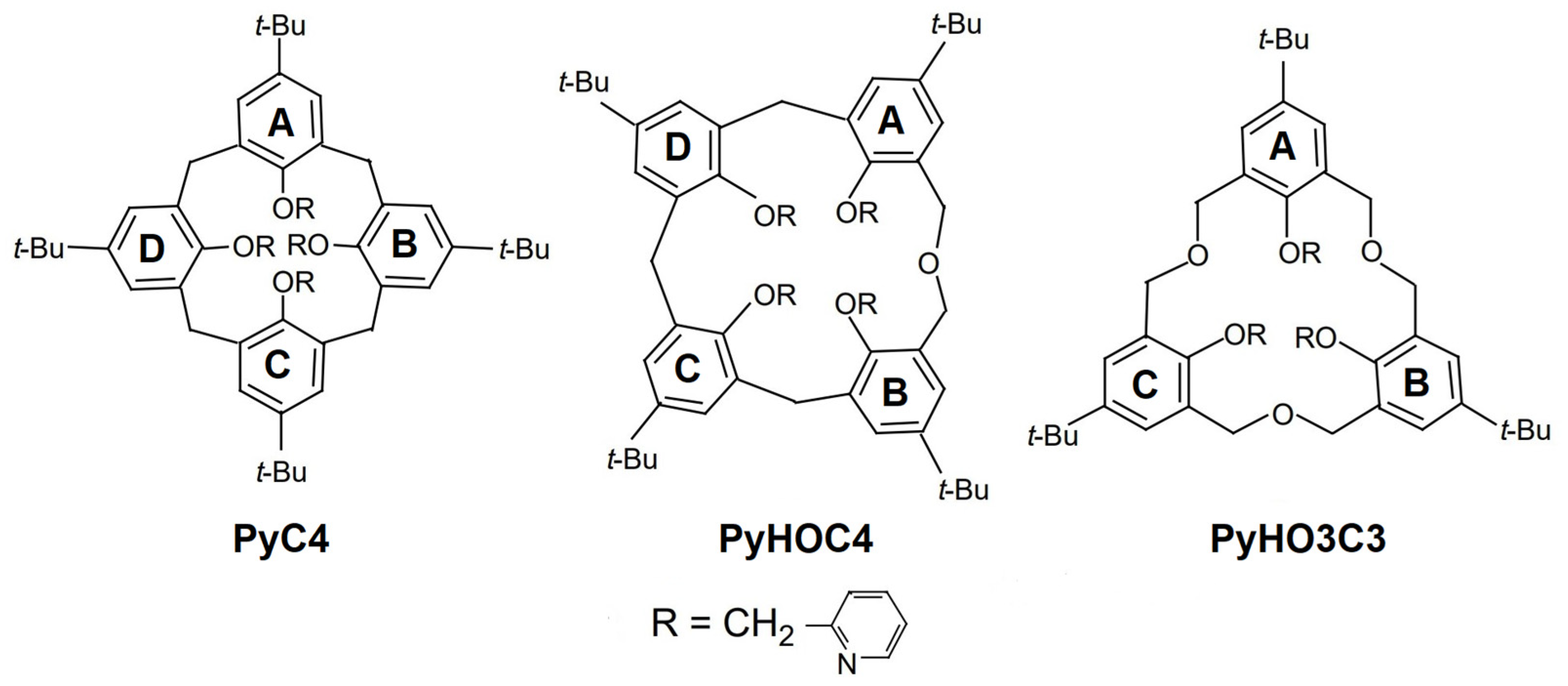

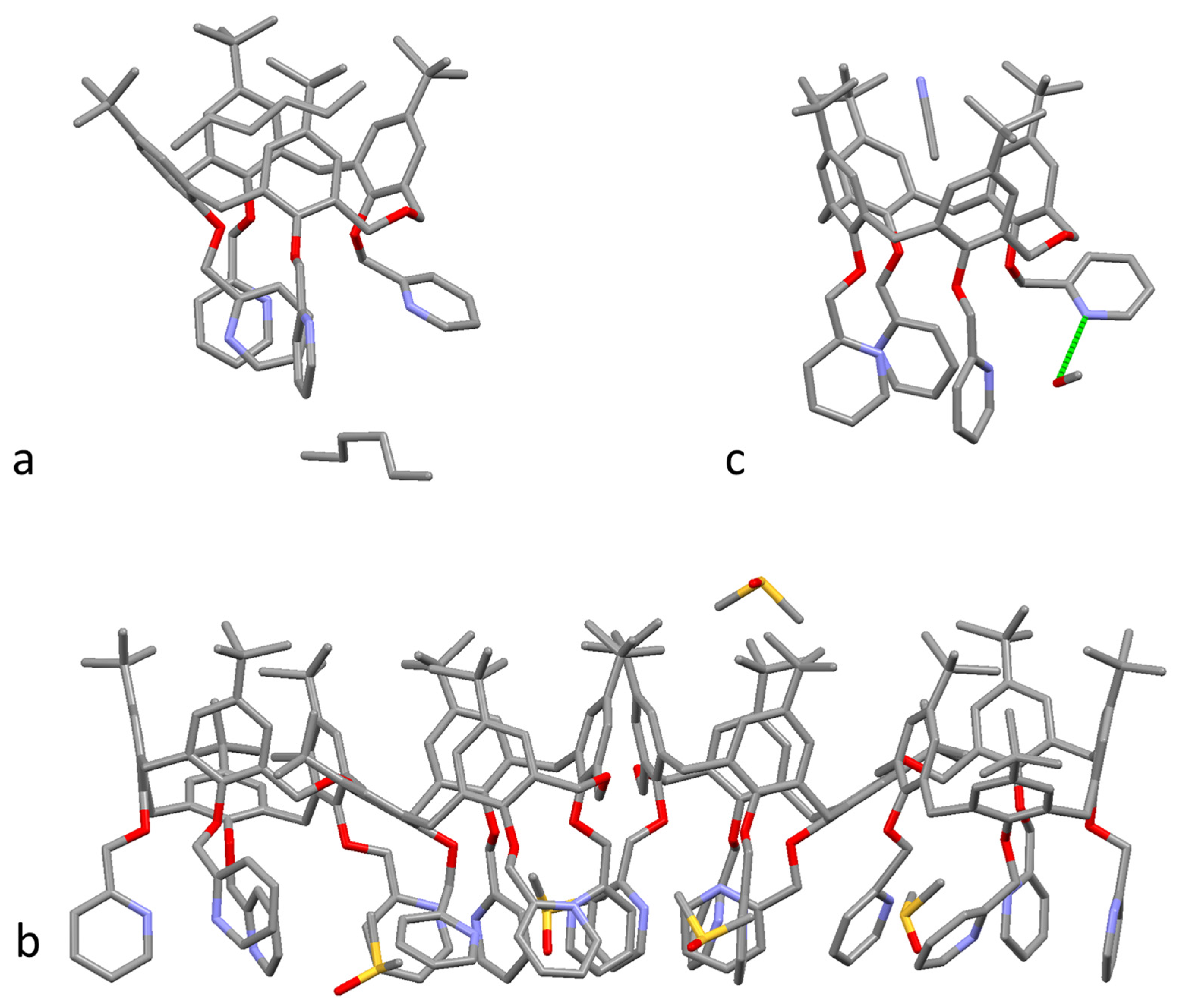

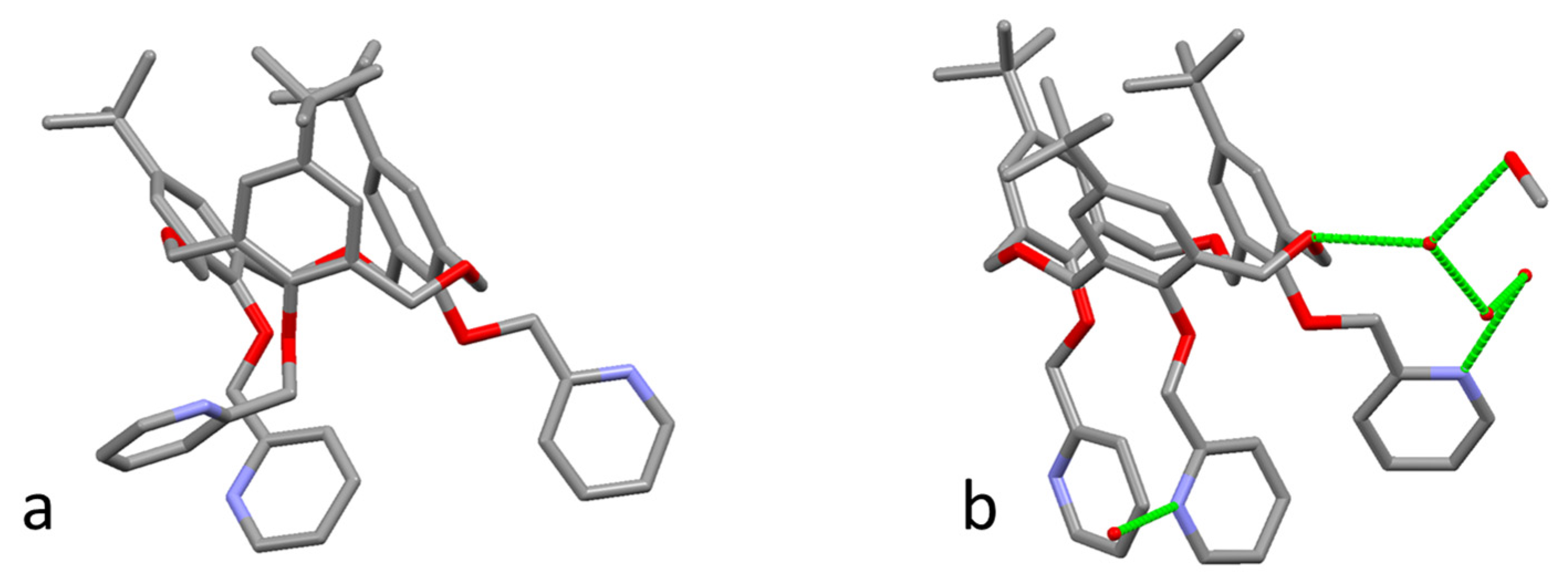
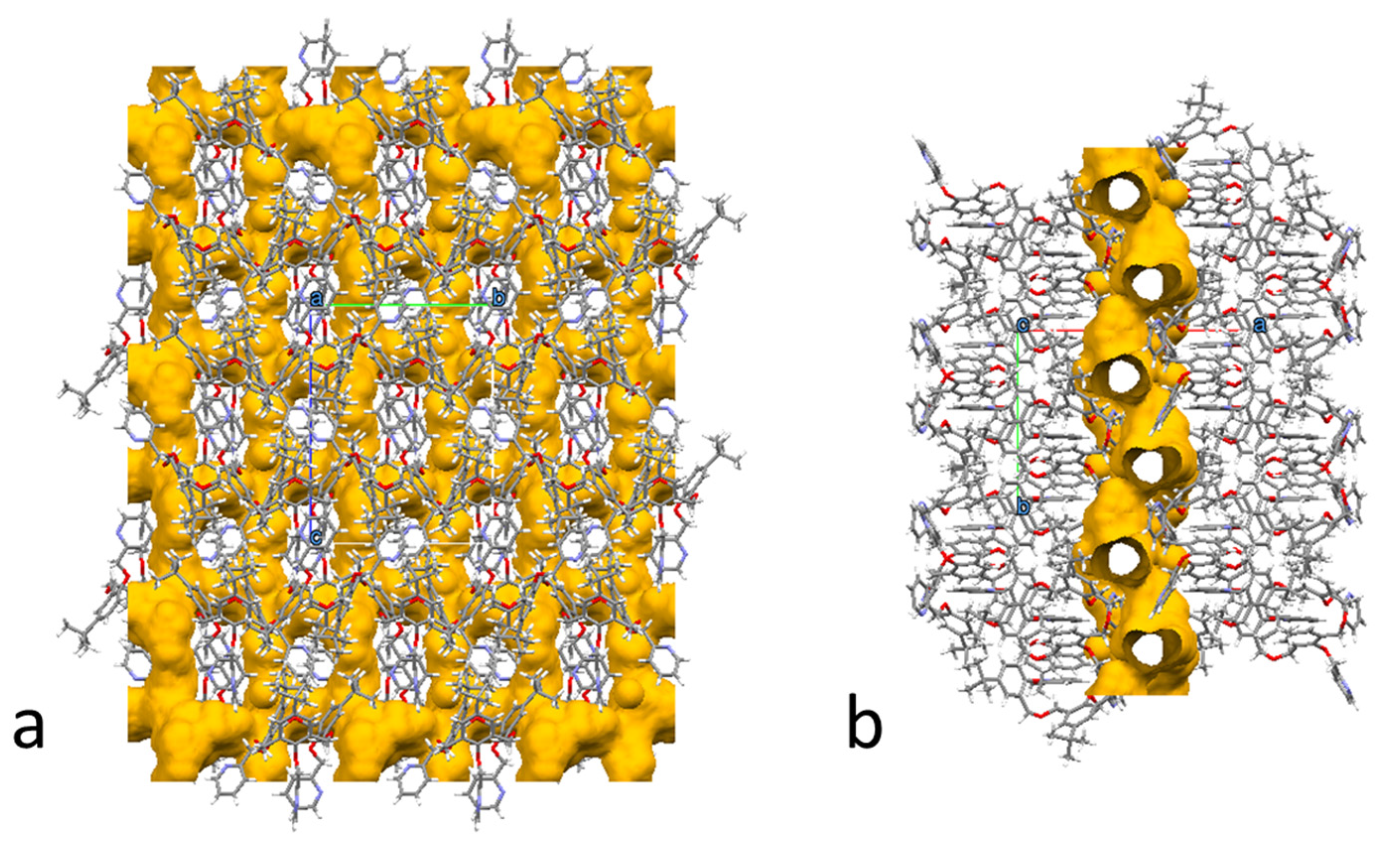
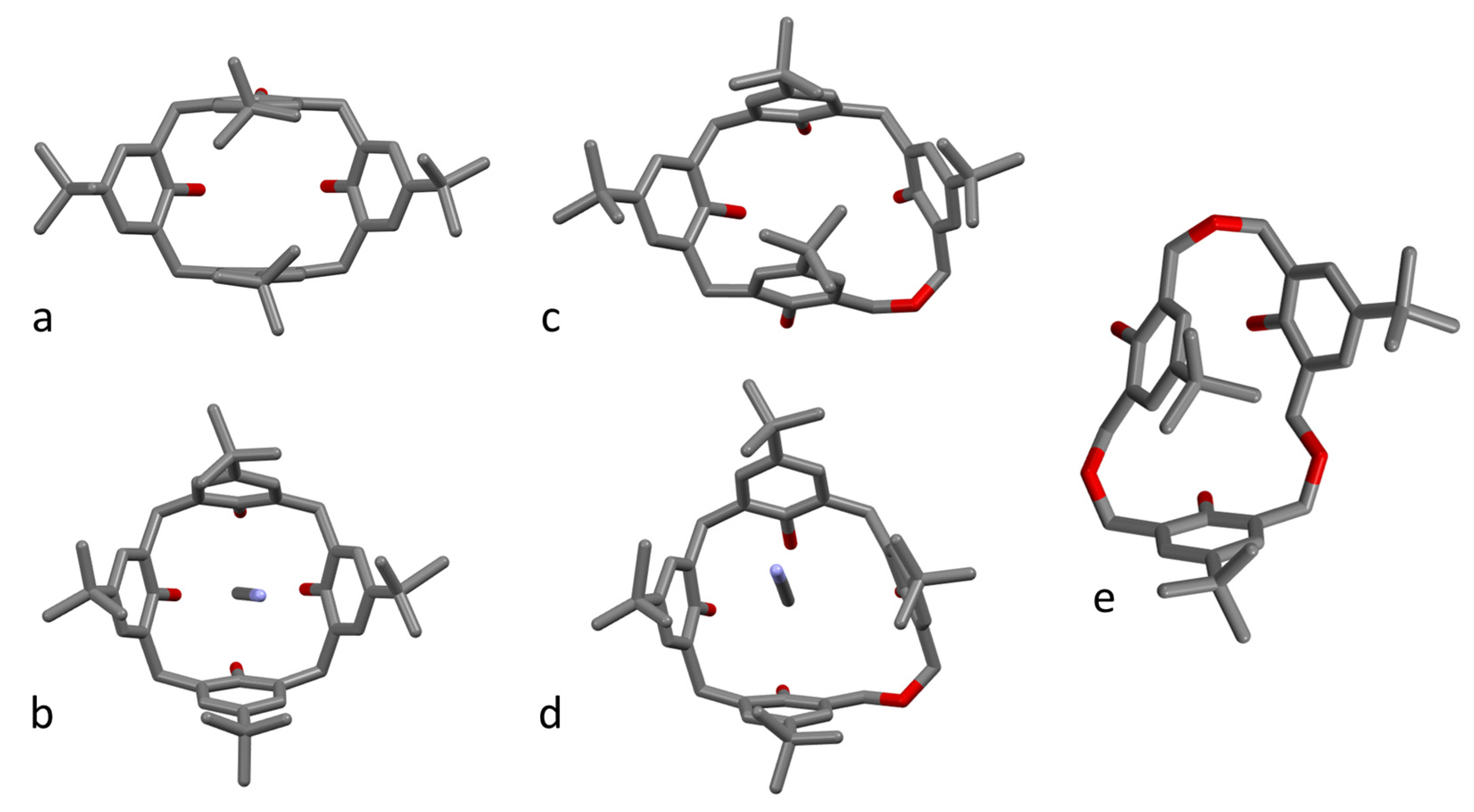
| Crystal | A-B | B-C | C-D | D-A |
|---|---|---|---|---|
| PyC4-MeOH-α | 96 | 94 | 92 | 91 |
| PyC4-H2O-α | 96 | 94 | 92 | 91 |
| PyC4-MeOH-β * | 96 96 | 92 93 | 94 95 | 93 93 |
| PyC4⸦MeCN-MeOH | 100 | 102 | 95 | 100 |
| PyC4⸦MeCN-H2O | 99 | 100 | 97 | 101 |
| PyC4 | 86 | 87 | 92 | 93 |
| PyHOC4-DMSO * * * | 59 58 62 56 | 90 95 91 91 | 103 97 102 99 | 97 98 95 102 |
| PyHOC4⸦MeCN-MeOH | 69 | 112 | 105 | 96 |
| PyHOC4-Hexane | 61 | 77 | 101 | 113 |
| C-A | ||||
| PyHO3C3 | 48 | 102 | 36 | |
| PyHO3C3-H2O-MeOH | 62 | 98 | 31 |
| Crystal | A | B | C | D |
|---|---|---|---|---|
| PyC4-MeOH-α | 128 | 98 | 128 | 91 |
| PyC4-H2O-α | 128 | 98 | 128 | 91 |
| PyC4-MeOH-β * | 136 135 | 96 93 | 130 131 | 89 91 |
| PyC4⸦MeCN-MeOH | 118 | 112 | 117 | 108 |
| PyC4⸦MeCN-H2O | 121 | 110 | 118 | 109 |
| PyC4 | 135 | 85 | 130 | 87 |
| PyHOC4-DMSO * * * | 117 119 116 119 | 72 76 74 70 | 135 136 134 136 | 102 98 100 103 |
| PyHOC4⸦MeCN-MeOH | 105 | 97 | 128 | 112 |
| PyHOC4-Hexane | 112 | 68 | 137 | 106 |
| PyHO3C3 | 57 | 119 | 134 | |
| PyHO3C3-H2O-MeOH | 66 | 110 | 133 |
Disclaimer/Publisher’s Note: The statements, opinions and data contained in all publications are solely those of the individual author(s) and contributor(s) and not of MDPI and/or the editor(s). MDPI and/or the editor(s) disclaim responsibility for any injury to people or property resulting from any ideas, methods, instructions or products referred to in the content. |
© 2024 by the authors. Licensee MDPI, Basel, Switzerland. This article is an open access article distributed under the terms and conditions of the Creative Commons Attribution (CC BY) license (https://creativecommons.org/licenses/by/4.0/).
Share and Cite
Joshi, S.; Hickey, N.; Marcos, P.M.; Geremia, S. Pseudo-Polymorphism in 2-Pyridylmethoxy Cone Derivatives of p-tert-butylcalix[4]arene and p-tert-butylhomooxacalix[n]arenes. Crystals 2024, 14, 343. https://doi.org/10.3390/cryst14040343
Joshi S, Hickey N, Marcos PM, Geremia S. Pseudo-Polymorphism in 2-Pyridylmethoxy Cone Derivatives of p-tert-butylcalix[4]arene and p-tert-butylhomooxacalix[n]arenes. Crystals. 2024; 14(4):343. https://doi.org/10.3390/cryst14040343
Chicago/Turabian StyleJoshi, Siddharth, Neal Hickey, Paula M. Marcos, and Silvano Geremia. 2024. "Pseudo-Polymorphism in 2-Pyridylmethoxy Cone Derivatives of p-tert-butylcalix[4]arene and p-tert-butylhomooxacalix[n]arenes" Crystals 14, no. 4: 343. https://doi.org/10.3390/cryst14040343
APA StyleJoshi, S., Hickey, N., Marcos, P. M., & Geremia, S. (2024). Pseudo-Polymorphism in 2-Pyridylmethoxy Cone Derivatives of p-tert-butylcalix[4]arene and p-tert-butylhomooxacalix[n]arenes. Crystals, 14(4), 343. https://doi.org/10.3390/cryst14040343









